hydraulic dustbin
The Evolution of Hydraulic Dustbins A Sustainable Solution for Urban Waste Management
In our rapidly urbanizing world, the challenges of waste management are becoming increasingly evident. As cities expand, so does the volume of waste generated, leading to overflowing landfills and environmental degradation. However, innovative solutions are being developed to mitigate these issues, one of which is the hydraulic dustbin. This modern waste disposal system not only enhances the efficiency of waste collection but also promotes sustainability and cleanliness in urban environments.
What is a Hydraulic Dustbin?
A hydraulic dustbin is a sophisticated waste management device designed to facilitate the efficient collection and disposal of urban waste. Unlike traditional dustbins that require manual effort to empty, hydraulic dustbins utilize hydraulic systems to automate the lifting and emptying process. This innovation significantly reduces the physical labor involved in waste collection and minimizes the risk of injury for waste management workers.
The core mechanism of a hydraulic dustbin involves hydraulic cylinders that are activated by a simple lever or button. When the dustbin reaches its capacity, waste collectors can easily activate the hydraulic system to lift the bin and empty its contents into a larger waste truck. This automation not only saves time but also improves the hygiene of the waste collection process by reducing direct contact with refuse.
Benefits of Hydraulic Dustbins
The implementation of hydraulic dustbins in urban areas yields numerous benefits
1. Efficiency Hydraulic dustbins streamline the waste collection process. Collectors no longer need to manually lift heavy bins, thus speeding up the time it takes to clear waste from streets. Cities can optimize their waste collection routes and reduce operational costs.
2. Improved Hygiene The reduced need for manual handling minimizes the risk of contamination and the spread of disease. The hydraulic lifting mechanism helps prevent spills and ensures that waste is securely contained during transportation.
hydraulic dustbin

3. Ergonomics Waste collection can be a physically demanding job, often leading to injuries among workers. Hydraulic dustbins alleviate this burden, allowing workers to perform their tasks without straining their bodies, leading to healthier workplaces.
4. Environmental Impact By promoting more efficient waste handling, hydraulic dustbins can contribute to a reduction in littering and illegal dumping. When waste is collected promptly and efficiently, there is less chance for it to accumulate in public spaces, which helps in maintaining a cleaner urban environment.
5. Aesthetic Value Many hydraulic dustbins are designed with aesthetics in mind, featuring sleek, modern designs that can blend into urban landscapes. This encourages proper waste disposal among residents, as the bins are visually appealing and more likely to be used.
Challenges and Considerations
Despite their advantages, the adoption of hydraulic dustbins is not without challenges. The initial investment in hydraulic technology can be significant, and cities must consider maintenance costs over time. Additionally, proper training for waste management personnel is crucial to ensure the hydraulic systems are operated safely and efficiently.
There are also practical considerations regarding the integration of hydraulic dustbins with existing waste management systems. Cities may need to reassess their waste collection routes and schedules to fully leverage the benefits of this technology. Public awareness and education campaigns can foster community support for new waste disposal technologies and encourage responsible usage.
The Future of Urban Waste Management
As we look towards the future, the need for innovative waste management solutions like hydraulic dustbins is more pressing than ever. Urban areas around the world are faced with increasing challenges related to waste production, and traditional methods are proving insufficient. By embracing technologies that enhance efficiency and promote hygiene, cities can better manage their waste, protect the environment, and improve the quality of life for their residents.
In conclusion, hydraulic dustbins represent a forward-thinking solution to the complexities of urban waste management. Their ability to automate the waste collection process not only benefits waste management workers but also enhances the overall cleanliness and sustainability of urban environments. As cities continue to grow, investing in such innovative solutions will be crucial for a greener, cleaner future.
-
The Smarter Choice for Pedestrian AreasNewsJun.30,2025
-
The Gold Standard in Round Drain CoversNewsJun.30,2025
-
The Gold Standard in Manhole Cover SystemsNewsJun.30,2025
-
Superior Drainage Solutions with Premium Gully GratesNewsJun.30,2025
-
Superior Drainage Solutions for Global InfrastructureNewsJun.30,2025
-
Square Manhole Solutions for Modern InfrastructureNewsJun.30,2025
-
Premium Manhole Covers for Modern InfrastructureNewsJun.30,2025
